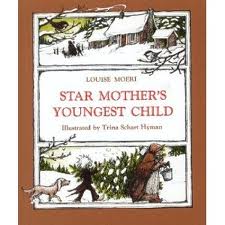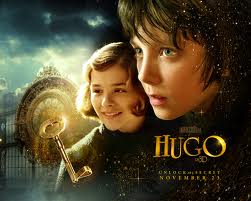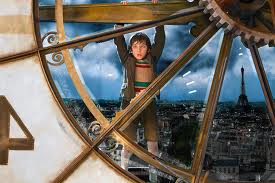Glen Huser’s Movie and Book Picks for December, 2011
 My Book Pick: Star Mother’s Youngest Child
My Book Pick: Star Mother’s Youngest Child
My book pick for this December is my favourite Christmas book – one I have read regularly over the years at Christmas to school children and members of my own family. It is Star Mother’s Youngest Child (Houghton Mifflin, 1975) with text by Louise Moeri and illustrations by Trina Schart Hyman. I first came across the book when I was reviewing children’s literature for the Learning Resources department of Edmonton Public Schools – and I immediately bought a copy for myself as well as ordering it for the school libraries where I was working. That was 35 years ago.
Moeri’s text presents us with the tale of a grumpy, reclusive old woman whose general displeasure with the world, now that her family is gone and the villagers nearby have forgotten her, heightens at Christmas time. “Just once,” she mutters, “I’d like to have a real Christmas, with a Christmas tree, and presents, and candles lit, and music, and a feast…”
Up in the heavens, Star Mother, who has been working madly to get the night sky tidy and beautiful for Christmas Eve, scolds her youngest child who is underfoot. But she stops and listens when he begs – pointing to the earth below — to “just once…celebrate Christmas like they do down there!”
As you might guess, Star Mother makes arrangements and her youngest child lands on the grumpy old woman’s doorstep. As he demands all of the pleasures of a Christmas day, the old woman grudgingly sets up and decorates a Christmas tree, prepares a special dinner, and even wraps a gift for him – a prized brooch she was saving to adorn her burial outfit. And, in the end, Star Mother’s Youngest Child has a special gift for her too (which I’ll leave for you to discover).
A simple story, but Moeri’s telling of it is filled with language that has been polished to the high sheen of a Christmas tree bauble. It reads aloud beautifully – especially if you care to work up a particularly grumpy voice for the old woman. For those who want to have the small volume in hand, there is the added pleasure of accessing Trina Schart Hyman’s black-and-white illustrations, detailed and expressive. Hyman is best known for her award-winning illustrations for picture books such as St. George and the Dragon, but the work she did here is something I hold close to my heart for its humour and humanity. In my mind they are part and parcel of the literary package, just as as John Leech’s original illustrations are for Dickens’ A Christmas Carol.
When I first discovered Star Mother’s Youngest Child, I shared my enthusiasm for the book with one of my best friends, David Twigge, who worked as a children’s librarian in Burnaby, BC. He too fell in love with it, and revisited it from year to year.
In the conclusion of Moeri’s narrative, a very tired Youngest Child trudges home to Star Mother and when she asks him to tell her about his adventure, he sleepily yawns and whispers, “It was enough.” David, who always fashioned his own Christmas cards, sent me a linocut of this scene and quoted these closing lines in the last Christmas card I received from him before he died from AIDS in 1994. I like to think his visit to Earth was as satisfying as Star Mother’s Youngest Child’s – that “it was enough.”
My Movie Pick: Hugo
My movie pick for December is the new 3D picture Hugo which I went to see twice last week. I was so enthralled on a first viewing that I was compelled to return and see the film two days later. A second look allowed me to savour more fully the absolutely amazing digital effects created by a team of artists that – if you read the credits – represents a population that could vie with that of a small city.
Hugo is based on Brian Selznick’s 1997 novel The Invention of Hugo Cabret – a book that, in key sequences, unfolds in full-page graphics. In fact, it is the only novel to win a children’s literature Caldecott Medal, an annual award for the most outstanding illustrations in a picture book. Selznick’s charcoal-toned pictures capture the wide-eyed wonder of a young orphan boy who lives in the clock tower of a Parisian train station in 1930. Abandoned by his alcoholic uncle who serviced the clockworks, Hugo has taken on this job as he attempts to restore an automaton that his father had been attempting to bring to working order before he was killed in a museum fire.
The automaton, we discover, is the original handiwork of the pioneer French film-maker George Melies from his earlier career as a magician and gadgetry wizard. Melies, now a broken man, with his films destroyed, the celluloid melted down and used for making boot-heels, operates a toy shop in the concourse of the train station. As he steals from Melies’ shop the bits and pieces he needs to mend the automaton, Hugo encounters Melies’ goddaughter, Isabelle, who becomes a friend and the two uncover the secret of her godfather’s past.
In adapting the novel, scriptwriter John Logan has been faithful to the spirit of Selznick’s story. The changes he’s made, building the character of the station inspector and giving him a mechanically-enhanced leg, developing parallel scenarios among the other characters in the train concourse (Madame Emilie who runs a café; the portly Monsieur Frick who is smitten by her; Lisette, a flower vendor who has captured the amorous attentions of the inspector) serve the transition from written word to theatrical narrative.
Martin Scorsese, the director, has also kept the tone and feel of Selznick’s book which was rather tricky as he added colour and technical dimensionality. How has he accomplished this? I think much of it has to do with the fact that he has such an in-depth sense of film history that he can replicate intuitively the pace and voice of a late-1920s-early-1930s Hollywood movie – and also the charming French films of that era. He pays homage not only to the first movies ever screened along with Melies fantastic pre-World War I pictures, but also Harold Lloyd’s hair-raising comedy and Chaplin’s sentimentality.
In the process, Scorsese has managed some perfect casting: Asa Butterfield not only has Hugo’s wonderful eyes but he has that kind of unaffected innocence that only a few child actors seem to manage; Chloe Grace Moretz as Isabelle falls nicely into sync with his character: Ben Kingsley brings a profound deep-voiced sadness to the aging George Melies; Sacha Baron Cohen knows how to kick the comic twitches of the station inspector into high gear with his one good leg.
But the real star of the film is its special effects. While paying homage to those film-makers who had audiences screaming as a train hurtled into a station, gasping as a department store clerk dangles high over a city street from the hand of a huge clock, or chuckling as a rocket plummets into the eye of the man in the moon; Hugo offers us its own advances in film-making. If you have a phobia about heights, as I do, you will barely be able to look at the dizzying perspectives within the clock tower of the train station. Chases through the station’s concourse are breathtakingly manic. The magic of digital artistry allows us to roam over the streets of Paris eighty years ago.
Give yourself a special treat this Christmas – go and see the 3D version of Hugo.
